Foraging for wild berries is definitely a prickly adventure, but the payoff is definitely worth all of the bother. Growing, raising, and hunting for your own groceries are the primary parts of a survival food plan, but foraging may also be essential to staving off starvation during a long-term disaster.
A prepper who is dependent upon shelf-stable food stockpiles and/or gardening may very well end up being a statistic, and not a survivor.
Disease or weather can quickly wipe out a garden and fire or marauders can destroy a stockpile of preserved or purchased food.
Even the most self-reliant prepping family set up well on a survival homestead could find itself suddenly forced to flee or rebuild after a fire.
Knowing how and when to forage is yet another way to take care of the food problem in a long-term disastrous situation.
When Is Berry Pickin’ Season?
Generally speaking, wild berries ripen and are ready to harvest in the middle to late summer months. But, as with all things in life, there are exceptions to this “rule”.
Where you live, what type of wild berries you are foraging for, and the weather have a whole lot to do when it is time to go into the woods to pick berries.
This year, thanks to the long periods of heavy rain and intense heat, the wild berries on our survival homestead were ready to harvest about three weeks ahead of their usual schedule. Not all of the berries on the bushes were ready, but that is common as they tend to come on in stages.
Blueberries and strawberries are prime examples of late spring through early summer harvestable wild berries.
It is best to locate the wild berry bushes through leaf identification in the early spring so you can monitor their growing progress and not miss the berry pickin’ season.
Wild berries can be found throughout the United States and North America. The best regions of our country to locate large patches of wild berries are the Midwest, the Northwest, the Southeast, and the Northeast.
Of course, rural areas are where you will find the most berries, but wild bushes can also be found in suburban and even urban areas.
But, when picking berries in such locations, the chances of them having been contaminated with chemical agriculture sprays and exposure to other potentially toxic debris, vastly increases.
Aggregate Fruit or Berries – What’s The Difference?
If you want to get really technical about it, a lot of the “wild berries” that foragers eagerly go on the hunt for annually, are not berries at all – they are aggregate fruits. Aggregate berries boast densely packed carpels, or fruit clusters.
Every tiny rounded end that forms say, a black raspberry, is actually its own little piece of fruit.
Aggregate berries are part of the rose family, and all grow on long cane stems that arch over to give a traditional bush look to the plant. These thickets the fruit grows upon are extremely brambly in nature and are filled with bristly thorns.
You Must Know What You are Dealing With
If you are planning on ingesting wild berries in any capacity, be it for survival purposes or not, you must start accumulating the knowledge and experience now in order to do so safely when you are actually in the field ready to pick some enticing berries from a wild grown plant.
Lots of edible berries look very similar to ones that are inedible, and some inedible, dangerous berries look just like delicious, nutritious ones that you should prioritize over all the others.
Comparing the berries might not be the way to go; you need to identify the berries based on the type of plant that produces them.
But let’s say you screw up, or you just roll the dice, and they both come up snake eyes. You have eaten a toxic berry. Oh no! Now what?
Well, depending on the type of berry, its ripeness and what sorts of compounds it contains, you might be facing anything from cramping to nausea, vomiting to diarrhea, and even symptoms as severe as seizure, coma and heart arrhythmia.
Some berries contain alkaloid compounds that are so toxic they can actually inflict permanent organ damage. Yikes.
Generally there is no substitute whatsoever for expert knowledge of what kind of plant that you are dealing with.
However if you are in an unknown region or looking at an unknown plant and are truly desperate for calories or just vitamins and minerals there is a generally reliable field test that might be able to help you, or at least head off true disaster.
Wild Berry Foraging Facts and Tips
- Never eat what you do not know. Wrongfully identifying a berry (or anything you stumble across) could prove to be a fatal mistake.
- If you are new to foraging, spend a few bucks on a quality identifying guide. I actually recommend buying a guide even if you are a seasoned forager so less accomplished wild edibles hunters in your clan would be able to pick food if you are no longer available as a survival food tutor.
- Learn as much as you can about the environment in your region so you can train your eyes to better spot safe to eat wild berries and other forest food. Typically, wild berries grow alongside the same type of plants – many of them edible as well.
- Pack a first aid kit and water with you during a foraging adventure. Do not go into the woods even before a SHTF event and just assume you will be going home uninjured – or back home at all.
- Never forage in an area you are not absolutely positive is free of potentially toxic agricultural sprays, predator traps, debris contaminants like motor oil and other fuel, or on private property.
- Never harvest even a succulent looking berry from a bush that is showing signs of an insect infestation, mold, or plant disease.
- Look over each individual berry before putting it in either your mouth or storage container for signs of disease, mold, or rotting.
- Unless you are in a dire survival situation or going to preserve the wild berries, do not pick a bush entirely bare.
- To help increase the amount of wild berry bushes you have on your survival retreat or in your favorite foraging area, simply broadcast a few seeds from the berries in quality growing spots to hopefully sprout new bushes for the following year.
- If you’re able to freeze your berries, it’s a good idea. Frozen berries hold up for months in a freezer as long as no moisture can get to them.
Disclaimer
The advice in this article is for information purposes only. You should only forage something if you know what you’re doing. In case of side-effects, consult your doctor as soon as possible. Neither the author nor the website or the company behind it shall be held liable for any side-effects as a result of applying the advice given in this article.
Wild Berry Toxicity Testing
Like with many other wild edibles (mushrooms in particular) berries can boast some very dangerous look-alikes. If you are unsure about a berry, the best advice would be to just pass it on by.
But, during a survival situation, there are a few ways to test the potential toxicity level of a wild berry to help determine whether or not it might be safe to eat.
- Pluck a few leaves from the bush and rub them onto a small patch on your bare arm. Watch the spot for several minutes to see if any type of a rash, swelling, bumps, burning, or itching develops.
- If the berry leaves pass the first toxicity test, rub a VERY small amount of the berry onto your closed lips. Do NOT rub the berry on like you are applying lip balm – that would expose you to way too much potential toxin.
- Wait a few minutes once again to determine if the berry rubbed onto your lips leads to any burning, tingling sensation, or bumps.
- Should the wild berry pass this test as well, nibble – and I mean nibble here fellow preppers – on a tiny portion of a single berry. Wait about 15 minutes for any ill side effects to develop. If you do not experience any burning sensation, nausea, vomiting, heartburn, sweating, or diarrhea, the chances are in your favor that the wild berry is indeed safe to eat.
Again I caution you, this simple four step testing system is by no means exhaustive or foolproof. It is entirely feasible that toxic side effects could appear much later after the 15 minutes – and by then it could be too late to save your life if you have eaten more of the wild berries.
Even when you are absolutely certain that a wild berry is safe to eat without resorting to the testing system above, that does not mean you might not have some type of allergic reaction when eating a new food – wild or not.
It is often too tempting not to toss back a bunch of the deliciously sweet berries into your mouth. This temptation might be too hard to avoid if you have gone without food for an extended period of time. Eating too much of anything on an empty stomach, especially something so sweet, could induce quite a stomach ache and vomiting.
Foraging Gear
When foraging for wild berries you may not have to journey deep into the forest, but you will be exposed to some potentially intense hiking and reaching into razor sharp brambles.
Going foraging unprepared could make an otherwise enjoyable outing that leads to an overflowing bucket of sweet wild berries a painful and frustrating endeavor.
- Gloves – wear leather work gloves when foraging for wild berries Even if you must remove one glove to actually pluck the berry from a vine, the gloved hand can hold back the briar on the bush so your face is not scratched to bits and you do not suddenly find yourself attached (re:tangled) to the brambles by your hair. The gloves will also protect your sweaty hands from coming into contact with anything poisonous before you wipe your dripping forehead or stinging eyes with the now contaminated hand.
- Clothing – No matter how hot it is, I always throw on some type of lightweight yet sturdy jacket over my sundress when going berry picking. My husband dresses far smarter and wears jeans. I don’t want to be all bundled up and extra hot, so I come home with scores of tiny scratches and sometimes dripping blood on my legs.
- Footwear – Boots. Always boots of some type. I don’t own tennis shoes, but folks who hunt in them wind up tangled in briars and cuts to their feet after the spiky vines have poked through the mesh. Also, you will be in snake territory when hunting berries, tennis shoes will not protect you from them.
- Container – A sack is annoying and problematic when foraging for wild berries. It will tear, topple over, or the bottom will fall out from the weight of your bounty – even if you double bag it. A sturdy container with a lid or a small opening works best. We usually cut a hole near the top of an empty milk jug and use it and it’s easy to tote the handle.
- Scissors or Pruners – Being able to cut or reach through thick brambles and difficult to remove berries is a must. You do not want to be elbow deep into an awesome berry patch only to find it too thick or durable to pick by hand. Sturdy scissors or snips of some type will make removing aggregate berries from their canes a snap.
How To Identify and Find Wild Berries
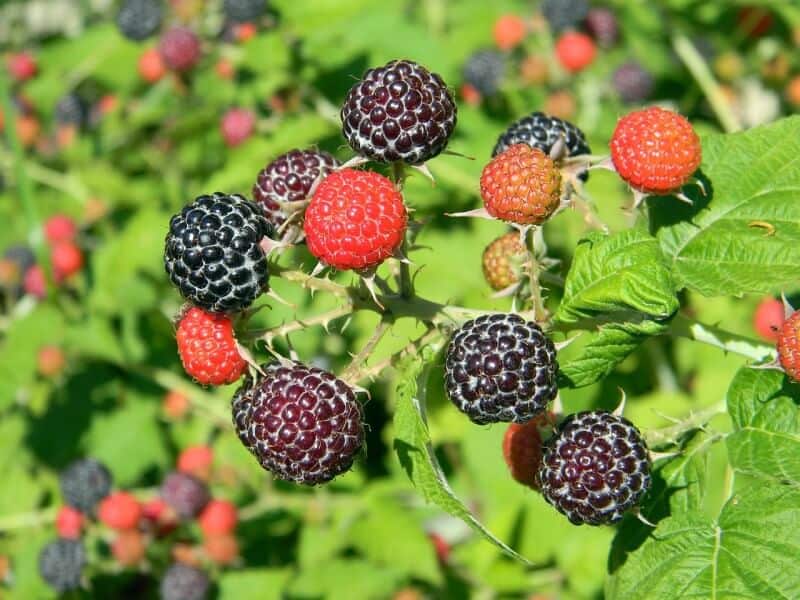
Black Raspberries
These delicious berries are also commonly referred to as wild raspberries and thimble berries. We are blessed with hundreds of these berry bushes on our survival homestead. While we have ample foraging material at our fingertips, we still have to beat the birds and free ranging goats and chickens to the bushes every summer.
The brambles the berries grow in can be taller than your head and deep, or so short you have to bend and reach through thin “branches” to get a berry at nearly ground level.
Black raspberries can be easily identified by the white cone shaped receptacle left on the vine before harvest time. A gathering of seeds forms around the cone, and changes color as they grow.
They are a vibrant red when they are growing and turn a deep purple to a black shade when they are ripe and ready to eat.
While you could eat the berries before they are ripe, the taste will be exceptionally tart, and often lead to a serious stomach ache. Novice foragers often confuse the unripened red berries for raspberries, and their gut pays the price if several handfuls are eaten at once.
You often find black raspberries growing along the edge of the woods, and especially on farm land bordering horse pastures and hay fields. These wild berry bushes tend to favor a partial shade environment in rich soil.
When searching for bushes in the early spring before buds begin to form, look for prickly bushes that boast leaves with serrated edges, and have a somewhat lighter shade of green on the underbelly of the leaves.
Typically, black raspberries are ready to harvest from late June through the first few weeks of July, depending upon the local climate. There are some varieties of wild black raspberries that are capable of producing fruit well into the early weeks of fall.

Blackberries
You may have to suffer a lot of thorn pricks to get to wild blackberry bushes, but your diligent and brave foraging efforts can come with a great reward.
The thick canes on a blackberry bush range in color from a red hue to a deep shade of green. Although blackberries look very similar to black raspberries, the fruit from this type of bush is almost always distinctly larger. It is not uncommon for wild blackberries to grow as big as your thumb.
Blackberries change in shade from white to green as they are growing. It is not until the wild berries are a deep purple or black that they are ready to harvest. Some berries may never fully mature, and still have some dots of red amid the black. These would be pretty tart berries, but safe to eat and some folks love them.
More often than not, the prickly stem of the berry remains attached when it is plucked from a bush. Make sure to look at the base of the berry before tossing it back into your mouth – or prepare to shout “Ouch!” and possibly a few curse words as you swallow.
Wild blackberry bushes are prone to growing on farms, and can reach heights of 20 feet tall. The reason these bushes get so much taller than their wild cousins – the black raspberry, is because their thick and densely briar covered vines convince all but the highly determined forager to leave them alone.
Although blackberry bushes may prefer a more secluded spot in the woods to grow than black raspberries, they can also be found bordering pastures or even right in the middle of an agricultural field.
Wild blackberries usually come on during the middle to latter weeks of summer, depending upon which region of the country they are located.
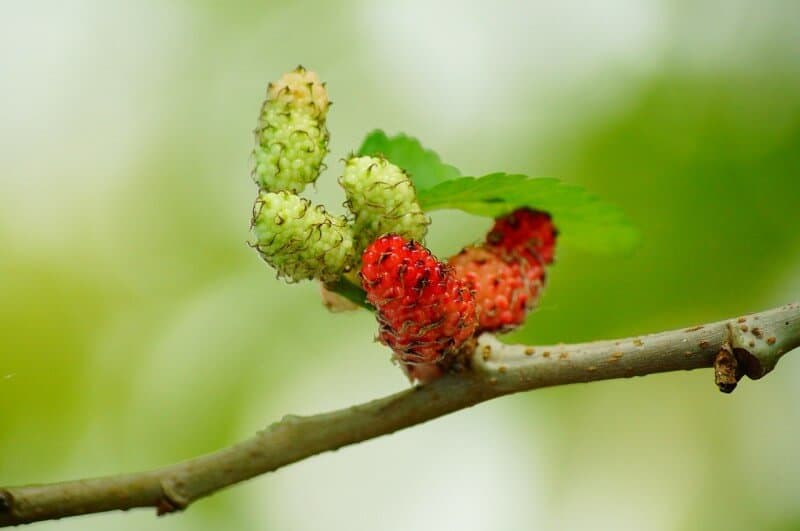
Mulberries
Even though they can grow from a tree, mulberries are still berries. There are three common variations of mulberries, so they can be found in shades of white, red, or a purple to black hue.
In my region, black mulberries are most common. They look like an elongated blackberry with a slightly football style shape. Red mulberries look a lot like raspberries, and are skinnier than typical blackberries. They begin looking white and then turn a light green before they ripen.
Mulberry tree leaves look similar to those on a maple tree but boast more of a heart shape with a distinctive serrated edge.
The whole fruit (berry) is directly joined to the stem, so there will be no white receptacle of any type left behind or attached to the berries, after it is picked.
Mulberries can be difficult to remove from the stem, cutting it free is easier than plucking. But, on the bright side, the stem is edible as well. It has a sweet yet somewhat tart taste.
It is typically ready to harvest in the late spring through early weeks of summer. Mulberry trees tend to grow along the edges of wooded areas, and along creek banks – often in spots where other plants do not easily grow.

Blueberries
These wild berries can grow on bushes that can reach as high as 20 feet tall. The bushes have warty like twigs and are a bell shape with hanging flowers.
Blueberries generally prefer sandy to slightly acidic, and dry soil, and can be found along wooded clearings in full sun areas of growing adjacent to large rocks – especially where patches of moss also thrive. In my personal experience, blueberry bushes often grow next to oak trees.
Wild blueberries are usually far tastier and juicier than those sold commercially. The middle of summer is the best time to go blueberry foraging.
Wild Strawberries
These delicious wild treats have a small look-a-like that is commonly referred to as a “false strawberry”, or a “mock berry.” They are a rather bland wild berry that can safely be eaten but have a bland taste. False strawberries are typically found in vegetable growing beds or near less forested areas.
Real wild strawberries grow along creek banks, and next to rivers. They are also commonly spotted along the forest edge near treelines – like many other types of wild berries.
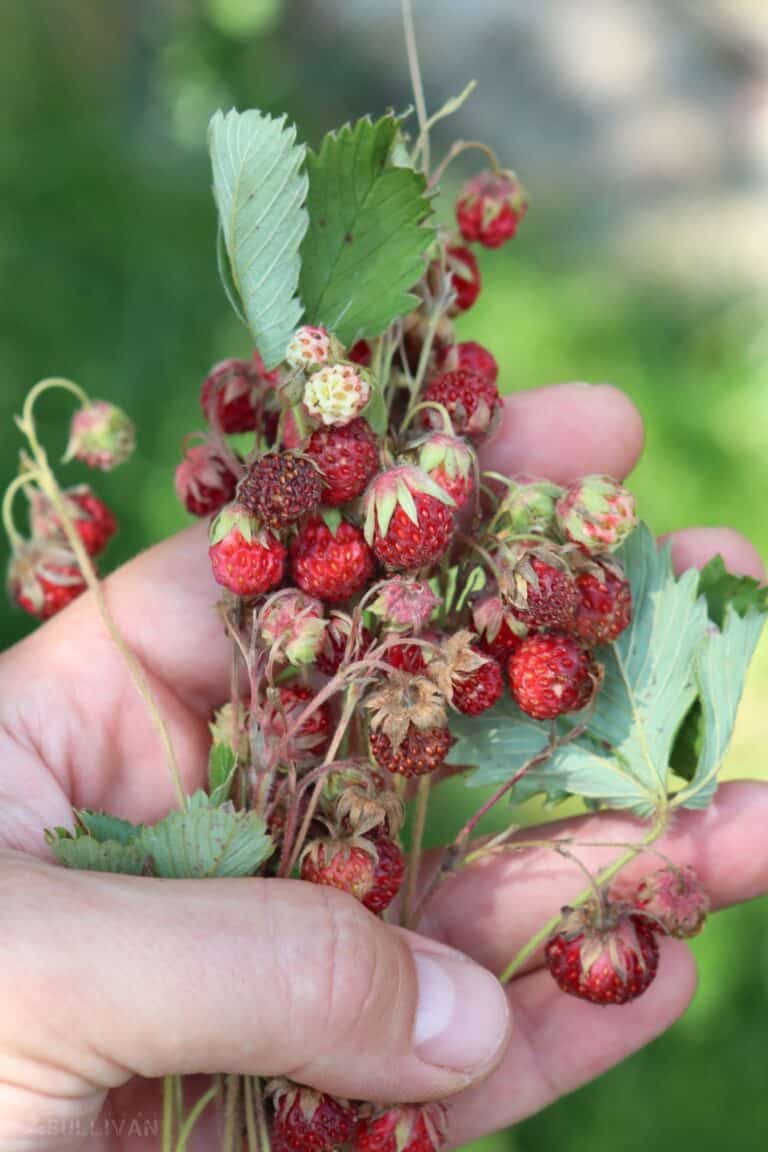
Although mock berries and strawberries look extremely similar, real wild strawberries boast white flowers when they are blooming. The fruit on false strawberries does not have a white flower and its fruit grows straight up.
If you taste one, it will not harm you (unless you have an allergic reaction) but the taste will let you know immediately you have foraged an impostor.
They both taste and smell a whole lot like the store bought variety – so much better.
Wild strawberries are most commonly found along waterway embankments and nearby slopes – or sometimes in untended fields. They prefer to grow in rich soil and in spots that are exposed to full sun.
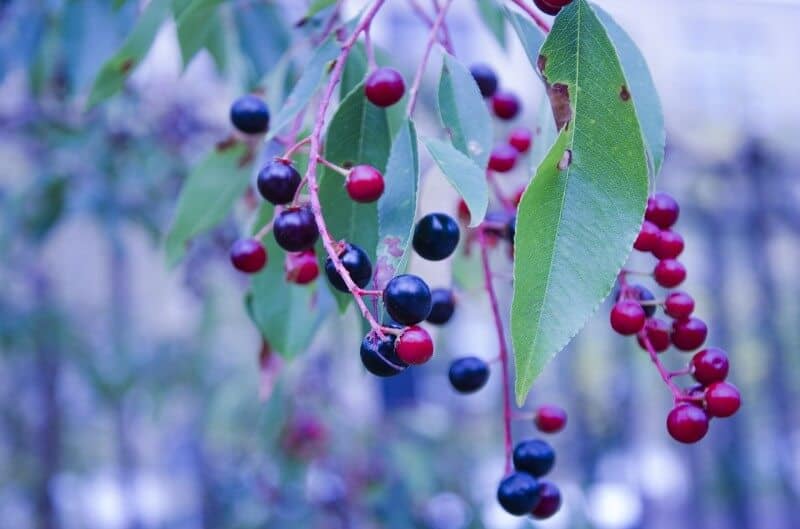
Huckleberries
Huckleberries grow as shrubs or bushes, preferring soil with low acidity levels.
Huckleberries are also a pretty shade of blue, but can easily be differentiated from blueberries by the crown they possess on one end of the fruit. They are small, yet their seeds are larger than those found in blueberries. It is not unusual for huckleberry seeds to get stuck in the forager’s teeth.
They can be harvested during the late summer through early fall, depending upon your local climate. In my opinion, huckleberries have a more enticing and robust flavor when harvested in the early days of September. These wild berry bushes are extremely susceptible to drought.
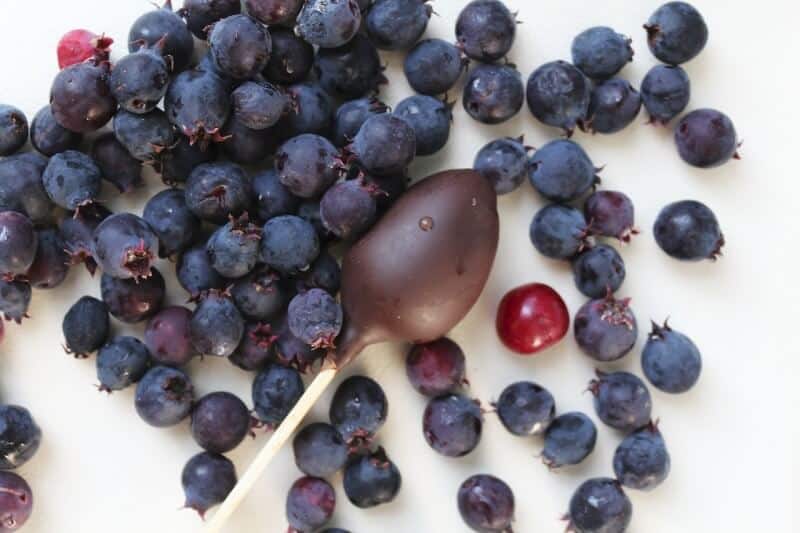
Juneberries
These wild berries are also commonly referred to as either serviceberries or saskatoons. They have a crown on one end, and are blue to purple in color.
Juneberries, like mulberries, grow from a tree rather than a bramble or a bush. They are most commonly found in the Pacific Northwest.
These wild berries have a glorious mixture of tartness and a sweet savory flavor. Juneberries are incredibly juicy and are rather plump. One of the traditional homesteading ways to use juneberries is to turn them into jam that has also been infused with rose petals.
Gooseberries
American Gooseberries are grown on a shrub and can produce yellow, green, black, or red berries. Some varieties, including the American Gooseberry, have semi-translucent berries. They almost look like grapes with stripes going through them. Gooseberries are a member of the currants family.
They vary in size with some being up to an inch in diameter and are covered in thin hair sometimes.. Be wary as a gooseberry bush tends to have large thorns and using some thick gloves would be in your best interest.
You will commonly find gooseberries in the northern regions of the United States and the southernmost parts of Canada since they are a cool weather berry. The North American variety is much more disease-resistant than the European strain.
Most foragers will use these berries in a delicious jam, or simply pickled in a mason jar for casual eating. They will stay fresh in your fridge for up to two weeks which is why they are commonly preserved.
Asian Wineberries
These tart wild berries are also prevalent through the bulk of North America. They are also found along the edges of the woods, and are sometimes referred to as Japanese wineberries.
Wineberries can usually be spotted easily thanks to their distinctive canes – they do not boast any briars, a rarity in the wild berry world. The canes Asian wineberries grow upon are also distinctively fuzzy in texture.
The ruby red berries shine like a jewel – or so the ravings of satisfied wild berry forages indicate. The berries grow from inside a fuzzy case, giving the bushes they grow upon the look of an outdoor Christmas decoration.
Like black raspberries, wineberries leave behind a white cone when picked. They have often been dubbed the “super raspberry.” They are typically ready to harvest in the middle to late weeks of summer.
Because Asian wineberries have been deemed invasive in multiple states, finding a wild bush is getting harder to do – and buying them from a garden supplier pretty is much impossible.
Less Common Berries To Forage
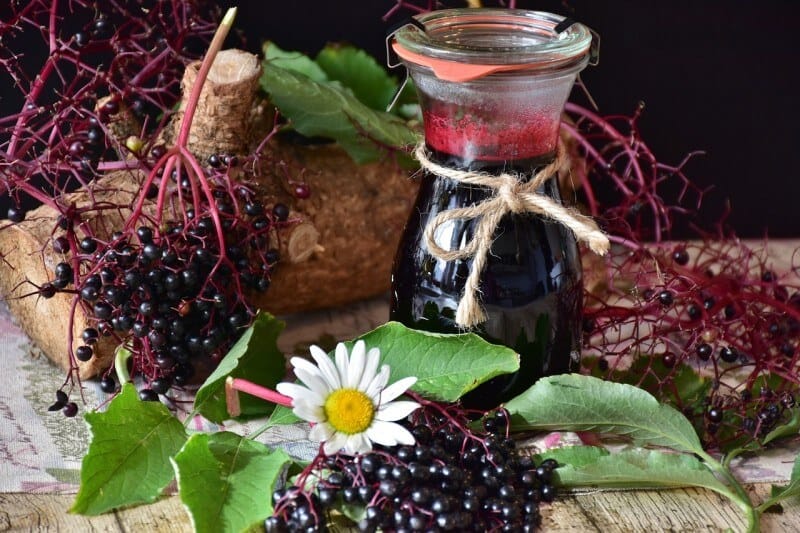
Elderberries
Foraging for wild elderberries is a double treat because both the berries and the flowers on these trees are edible. The berries should (must is a better word) be cooked before consuming them. The heating process deactivates the quite possibly toxic compounds in the elderberries.
Always make sure all of the leaves, stems, and bark are completely removed before munching on or using the elderberries in recipes because these parts of the trees are all highly toxic.
Elderberry flowers taste as good as they smell, hence why they are so often used to make wine, lemonade, tea, and liquor.
Typically, elderberries are most often foraged to make medicinal and fever and cold symptom-reducing syrup or hot tea. When the berries are processed in this manner their high level of vitamin C is harnessed and used as an immune system booster.
The most commonly available elderberry varieties available to forage include American black elderberries, blue elderberries, and black elderberries.
Elderberry trees tend to grow not at the edge of the woods like most berry bushes and brambles, but deep in the forest environment. They range in height from 10 to about 25 feet tall. Rivers, creeks, and wetlands located in a wooded environment are perfect spots to forage elderberries.
Flowers on elderberry trees start to bloom during the final weeks of spring into the middle of summer. Elderberries do not appear and mature until later in the summer, and into the early days of fall.
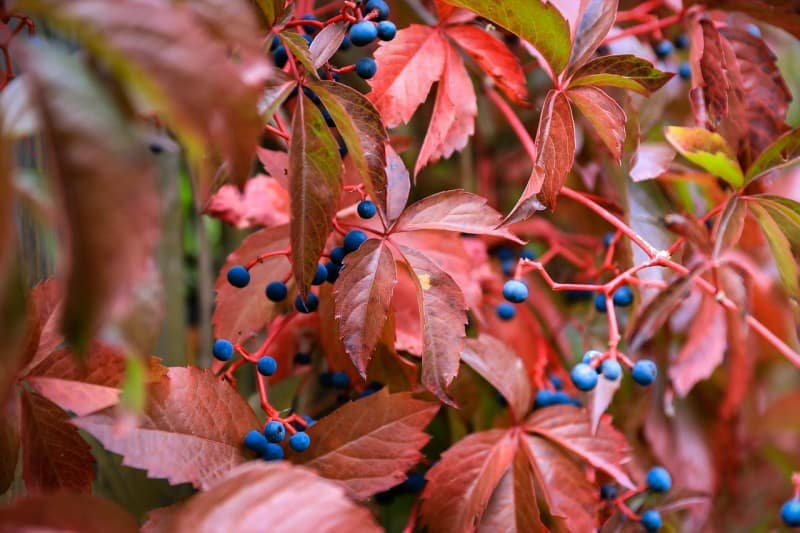
Muscadine
These berries are typically referred to as wild grapes. Muscadines are primarily foraged in the southeastern United States. They are a bright shade of light green as they grow, but turn a deep purple once they mature and are ready for harvesting.
Muscadines boast large seeds and can be consumed either raw or cooked. They are a considerably fleshy berry with a distinct sweetness. Wild grapes can be a delight to discover and eat by the handful, but they are most often used to make wine and jam.
They are often found along the edges of the woods in partially shady areas. Wild grape vines often grow rampant in clusters, and use any abandoned man-made or natural structure as a trellis to garner more access to the sun. A single tendil grows opposite each leaf.
Muscadines have a gelatinous flesh, and chewy and thick skin. The wild grapes can be crushed to make grape oil and the white powdery substance on the skin is a natural yeast that is often used during the wine fermentation process.
During a survival situation, you could use the thick grapevines the muscadines grow from as an emergency water source. Cut through the thickest grapevine you can find and manipulate to free it from the rest. Next, cut it open at the bottom and collect the water that drips out.
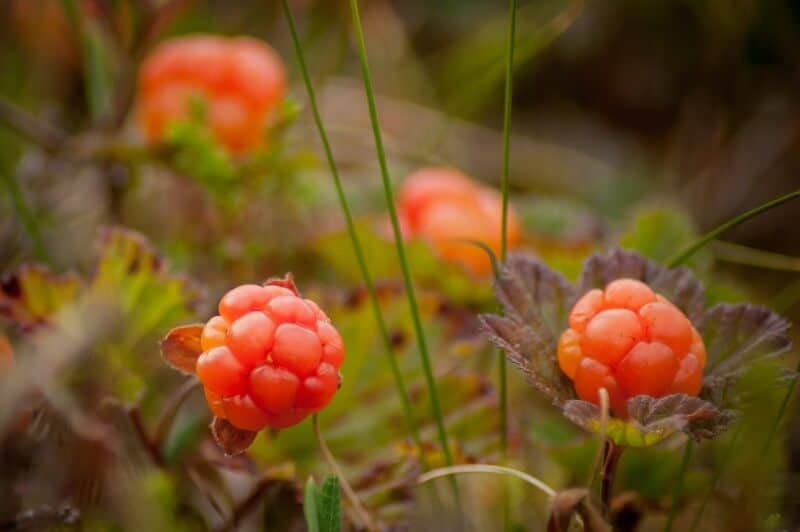
Cloudberries
These beautiful and delicate wild berries are incredibly hard to find – perhaps that is why gourmet chefs consider them a delicacy.
Cloudberries look like faded raspberries. They boast a juicy texture with a creamy flest. But, their taste is more like a green apple – a bit sour, than that of a sweet raspberry.
These wild berries are not usually eaten raw as a snack, but used to make jams, vinaigrettes, liqueur, teas, and preserves. Cloudberries have long been used in teas, and tinctures as an active ingredient in home remedies designed to treat scurvy.
Cloudberries grow in only a very few places in the United States, Alaska, Washington state, and Minnesota being chief among them. If you are foraging in Norway or Finland, you are far more likely to come across them.
The berries are a deep shade of red when growing and then turn to the glowing orange they are known for when ripe and ready to pick.
Cloudberries typically grow only in high-altitude locations and in wooded areas around bogs, wetlands, and sometimes even swamps. They require an enormous amount of water to grow. If you are foraging in a place where mosquitoes would love to live, that is the spot where cloudberries might appear.
Each cloudberry plant grows only one flower, which in turn grows a single stem with one berry. It is also the only berry that I know of that can be picked before it is ripe, and then ripen over the course of the next few days after being detached from its stem.
Even though they are tiny, cloudberries boast more vitamin C than a single orange. They are also chock full of omega 3 and omega 6. They have large seeds and at first glance by a novice, could look like unripened or scorched raspberries.
Just Be Careful When You Forage…
The most important aspect of foraging for wild berries is making sure you properly identify anything you put in your hand, in your bucket, and definitely into your mouth. Some berries or berry-like fruits that grow wild in the woods across the country can be toxic at a lethal level.
Tossing the wrong berry into your buckets among scores of safe to eat ones could make you and your loved ones gravely ill. No wild berry-picking guide in the entire world, either online or in print, can substitute for years of skilled foraging – or cover every possible tree, bush, or bramble you might discover.
The more you learn about all of the wild edibles and toxic plants growing in your region, the safer your wild berry foraging efforts will be. The vast majority of wild plants have natural companion plants.
Once you learn what tends to grow in guilds in the woods and pastures where you live, it will be easier to find what you are searching for, and to avoid things that can make you sick.
Frequently Asked Questions
Foraging for wild berries is an exciting adventure and it’s always made my day to come back home with a huge haul that I can turn into so many possibilities. Here are some of the most frequently asked questions about foraging for wild berries.
How can you tell if a wild berry is edible?
The first thing you should do before going out to forage for berries is to buy a reputable field book. They will outline what berries you should stay away from as well as best practices when you do go out.
These guidebooks often include in-depth images and little points about the berry that makes it stand out from others.
Avoid yellow and white berries, unless you are familiar with them since the majority of them are poisonous. Aggregated berries like raspberries and blackberries are generally safe to eat.
Around 90% of the black, blue, and purple berries are consumable. Be mindful around bright red berries, be sure to check the field guide as some can cause reactions within your body.
There is an old trick where you can break the berry in your fingers and rub the juice on your skin. If there is any kind of reaction, such as hives or swelling, then the berry is probably toxic. No reaction? Check your guidebook just to be on the safe side.
Where is the best place to find wild berries?
The nice thing is that the majority of berries can be found right in your backyard or in your neighborhood. Most communities have a river that runs through them, and banks along the shore are great places to find wild berries. Try to look for sunny places as berries need that energy to grow large and ripen.
Since most animals in the area take advantage of the wild berry harvest as well, any place that has a lot of wildlife will also be generous in the berry spoils. It’s important to note here that you want to remember to leave some of the berries for the birds and other wildlife.
Are berries good for your health?
Wild berries not only taste delicious but there are various health benefits that are tacked on. Keep in mind that everyone is different and the benefits can vary depending on your existing health. Be sure to do your own research and make the decision on whether or not you should be eating them.
Health advantages from eating berries include:
- Berries are composed of simple sugars which help control insulin production.
- You can get a decent amount of fiber from eating wild berries. Good for digestion and bowel movements.
- Antioxidants are good for your immune system and berries are full of them. Anthocyanins are one such type of compound.
If you’re looking for potent health boosters then berries are something you should incorporate into your diet.
Can you eat berries that have fallen off the bush?
You might notice that sometimes there are berries that have fallen off the branch and while you are tempted to eat them, have walked away because they are on the ground.
As long as the berries are while and there are no signs of infestation then you can eat them if they’re on the ground.
In fact, sometimes you’ll need to shake the bush to get all the berries easily accessible. Otherwise you’ll be picking off the branches forever.
This is the case when hunting for mulberries. It’s best to shake the bush until the berries all tumble down. Then you can either catch them in a basket or pick them up off the ground.
What can you do with the wild berries that you’ve harvested?
Eating wild berries fresh is all well and good, but you probably want to have them around when they aren’t naturally growing or enjoy them prepared in some dishes.
Wild berries make for excellent jams and jellies which you can store preserved for several months. Additionally you can turn the fruit into filling for pies and other desserts.
If you have a dehydrator you can sap all the moisture out of the berries and enjoy them as treats or in your oatmeal during the winter months.
They hold up for years if they are kept someplace like a cellar. Mashing up the berries before dehydrating them will turn them into a fruit leather which is an excellent energy boosting snack.
Wild Berry Recipes
Here are a couple of easy recipes that you can try with your foraged berries. They require minimal ingredients and prep, which means they are easy to do out in the bush. No fancy kitchen needed.
Wildberry Jam (Without Pectin)
Ingredients
- 2 cups of your favorite wildberry (or add a combination of a few)
- ¾ cup of sugar (you can use maple syrup or honey)
- 1 ½ tablespoons of lemon juice
Directions
- Be sure to place a small plate in the freezer as it’s going to help test the consistency of your jam. This step is optional.
- Add all of the ingredients to a small pot and bring to a boil.
- Cook for another 10-15 minutes until it’s thickened up nicely.
- At this point take a spoonful of your jam and put it on that plate you put in the freezer. Tilt your plate sideways and if the jam moves slowly across the plate, you’re done. If it moves quickly then return to the heat and cook it for another 2 minutes. Try it again and repeat if necessary.
- You’re done! If you’re not going to be canning this jam then simply pop a lid on it and place it in a cold box or refrigerator. It’ll hold for a couple of weeks after being opened.
Berryful Crumble
Ingredients
- 1 cup of your favorite wild berries
- 2 tablespoons maple syrup or honey
- ½ cup of granola or muesli
Directions
- Pour berries into a pot with sugar and toss together. You want them evenly coated.
- Bring the berries mixture to a boil over medium heat.Try not to have the heat up to high or the sugars will burn on the bottom of the pot.
- Thicken mixture for about 5-6 minutes. You want it to not be runny, but not quite jam texture, The granola will end up absorbing some of the liquid.
- Take off the heat and add in your granola. Stir and let cool for a few minutes.
You can get more recipe ideas here.
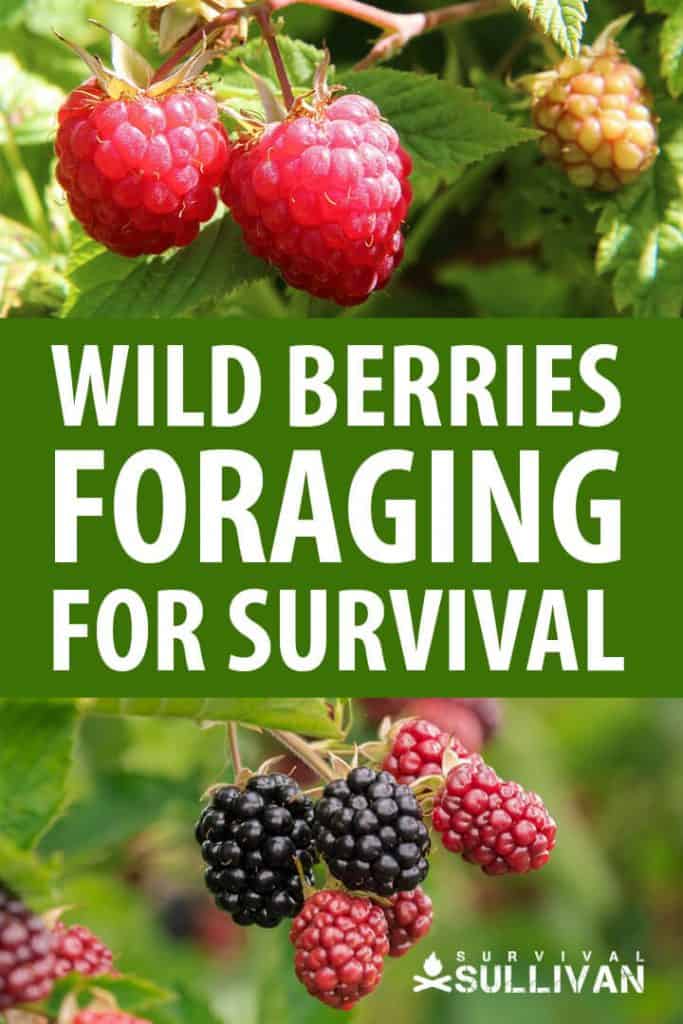

Tara Dodrill is a homesteading and survival journalist and author. She lives on a small ranch with her family in Appalachia. She has been both a host and frequent guest on preparedness radio shows. In addition to the publication of her first book, ‘Power Grid Down: How to Prepare, Survive, and Thrive after the Lights go Out’, Dodrill also travels to offer prepping tips and hands-on training and survival camps and expos.

HOW DO I GET FULL COPIES WITH PICTURES
Good article! I have been foraging wineberries for years; they are quite plentiful in my area if one looks. They make a wonderful jam or jelly. A food mill is highly recommended because they have tons of little seeds. Adding some cinnamon while preparing the berries for jam cuts down on the tartness and compliments the flavor so well that it tastes like Christmas!